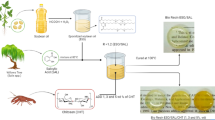Abstract
Styrenated sucrose esters of soybean fatty acids were successfully synthesized and the coatings properties were found to be comparable to a commercial styrenated alkyd while having lower volatile organic content at comparable solids content. A series of reactions were performed which varied the percent styrene incorporated into the resin. The dry time was significantly reduced as the styrene content increased which was a result of having more hard polystyrene chain segments. Tack-free times of ≈30 min were observed for resins containing high amounts of polystyrene. Nuclear magnetic resonance spectroscopy indicated residual bisallylic hydrogens were present which are capable of further crosslinking through autoxidation after film application. The addition of cobalt and zinc driers reduced the drying time which indicates that autoxidation is occurring. Furthermore, the styrenation reaction was extended to make water-reducible resins. These resins were crosslinked with a melamine–formaldehyde resin resulting in biobased thermosets having high solvent resistance, high hardness while retaining good flexibility.











Similar content being viewed by others
References
Meier, MAR, Jürgen, OM, Ulrich, SS, “Plant Oil Renewable Resources as Green Alternatives in Polymer Science.” Chem. Soc. Rev., 36 (11) 1788–1802 (2007)
Wicks, ZW, Jones, FN, Pappas, SP, Wicks, DA, Organic Coatings, 3rd ed. Wiley, Hoboken, 2007
Li, F, Larock, RC, Synthesis, Properties, and Potential Applications of Novel Thermosetting Biopolymers from Soybean and Other Natural Oils, pp. 727–750. CRC Press LLC, Boca Raton, 2005
Hewitt, DH, Armitage, F, “Styrene Copolymers in Surface Coatings.” J. Am. Oil Chem. Soc., 29 (312) 109–128 (1946)
Schroeder, H, Terrill, R, “Styrenated Drying Oils.” J. Am. Oil Chem. Soc., 26 (4) 153–157 (1949)
Bhow, NR, Payne, HF, “Styrene Copolymers in Alkyd Resins.” Ind. Eng. Chem., 42 (4) 700–703 (1950)
Hoogsteen, HM, Young, AE, Smith, MK, “Styrenation of Dehydrated Castor Oil.” Ind. Eng. Chem., 42 (8) 1587–1591 (1950)
Harrison, S, Tolberg, W, “Peroxide Catalyzed Polymerization of Styrene in Pure Fatty Methyl Esters.” J. Am. Oil Chem. Soc., 30 (3) 114–117 (1953)
Solomon, DH, “Vinyl Acrylic Modified Alkyds.” J. Oil Colour Chemists Assoc., 45 88 (1962)
Redknap, EF, “The Reactions of Drying Oils with Hydrocarbons.” J. Oil Colour Chemists Assoc., 43 260 (1960)
Solomon, DH, The Chemistry of Organic Film Formers, 2nd ed., p. 412. Robert E. Krieger Publishing Co., Inc, Malabar, 1977
Moad, G, Solomon, DH, The Chemistry of Radical Polymerization, 2nd ed., p. 35. Elsevier, Kidlington, 2006
Akbas, T, Beker, ÜG, Güner, FS, Erciyes, AT, Yagci, Y, “Drying and Semidrying Oil Macromonomers. III. Styrenation of Sunflower and Linseed Oils.” J. Appl. Polym. Sci., 88 (10) 2373–2376 (2003)
Gultekin, M, Beker, U, Güner, FS, Erciyes, AT, Yagci, Y, “Styrenation of Castor Oil and Linseed Oil by Macromer Method.” Macromol. Mater. Eng., 283 (1) 15–20 (2000)
Khot, SN, Lascala, JJ, Can, E, Morye, SS, Williams, GI, Palmese, GR, Kusefoglu, SH, Wool, RP, “Development and Application of Triglyceride-Based Polymers and Composites.” J. Appl. Polym. Sci., 82 (3) 703–723 (2001)
Totty, SM, Meier, JA, “Low Temperature Bake Water-Reducible Acrylic Enamel.” GB2004285A, 1979
Mallégol, J, Gonon, L, Commereuc, S, Verney, V, “Thermal (DSC) and Chemical (Iodometric Titration) Methods for Peroxides Measurements in Order to Monitor Drying Extent of Alkyd Resins.” Prog. Org. Coat., 41 (1–3) 171–176 (2001)
Acknowledgments
The authors would like to thank USDA Cooperative State Research, Education, and Extension Service under grant number 2007-38202-18597 for funding.




